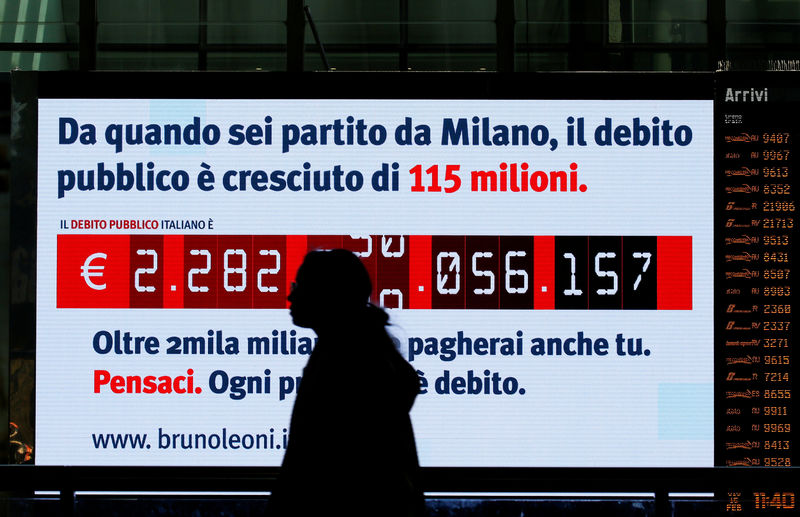 © Reuters. FILE PHOTO: Woman walks past a “debt clock” screen, installed by Bruno Leoni Institute’s analysts, displaying Italy’s public debt at the Termini central station in Rome
© Reuters. FILE PHOTO: Woman walks past a “debt clock” screen, installed by Bruno Leoni Institute’s analysts, displaying Italy’s public debt at the Termini central station in RomeBy Dhara Ranasinghe
LONDON (Reuters) – Italy’s borrowing costs continue to slide even though many big investors are singling it out as the euro zone member most vulnerable to a withdrawal of European Central Bank stimulus.
The third-largest of the 19 economies that use the euro is second only to Greece as the bloc’s most indebted, and is seen as fragile even after recovering from a decade in or near recession.
But as expectations grow that the ECB will wind down its 2.55 trillion-euro ($3.14 trillion) bond-buying program late this year and start lifting interest rates in 2019, Italian bonds continue to surprise with strong gains.
The yield premium investors demand for holding Italian 10-year bonds over top-rated German debt () () is 133 basis points — less than before inconclusive March 4 elections delivered a surge for populist, high-spending parties.
“The question is, if the idiosyncratic issues won’t impact Italian bonds, what will? I think what will impact them is the broader withdrawal of monetary stimulus across the euro area,” said Scott Thiel, deputy chief investment officer for fixed income at BlackRock.
(Graphic – Resilient: Italy’s bond market – http://reut.rs/2FSLJyT)
Thiel is underweight Italian bonds, and believes the ECB’s withdrawal of stimulus will not be as smooth as the winding down of quantitative easing (QE) in the United States. Not only is the ECB’s $5.6 trillion balance sheet larger than the U.S. Federal Reserve’s $4.4 trillion, it is, unlike the Fed’s, still expanding.
The ECB also has to be wary of individual country risks as withdrawing stimulus may have differing impacts within the bloc.
Some factors explain the resilience of Italian bonds. Data suggests Asian investors are returning to European bond markets thanks to a strong economy and positive yields, while the increasing cost of dollar investments encourages a switch to euro zone assets.
STOCK VS FLOW
The slow pace at which the ECB is set to run down its balance sheet — by letting its “stock” of bonds mature rather than selling them off — should also continue to support debt markets for some time after new asset purchases end.
In addition, the central bank plans to reinvest cash from maturing bonds back into debt markets, helping limit upward pressure on bond yields.
The ECB is estimated to hold up to 28 percent of Italian government bonds. According to Capital Economics, a shortage of eligible bonds in the euro zone has forced the ECB to buy 15 billion euros extra of Italian debt since 2015 for QE.
“When they finish they will own one-third of Italian bonds and at maturity they will buy back (reinvest). For me, the stock is a very strong argument,” said Roberto Coronado, senior portfolio manager, investment grade credit at PineBridge Investments.
But for others, the declining “flow” of ECB bond purchases cannot be ignored and as that occurs, investors are likely to pay more attention to individual country risks — putting widening pressure on bond spreads.
Bond market heavyweight PIMCO’s chief investment officer Andrew Balls identified Italy as the “long-term challenge” as the euro zone moves out of the stimulus era.
“If you have a recession and a deterioration in terms of fiscal metrics, you have the ECB out of QE by that point … you could have a rerun of a lender of last resort type crisis,” PIMCO’s Balls said.
According to Jefferies, ECB asset purchases in Italy have fallen to around 3.5 billion euros at the start of 2018, from around 9 billion between April and December last year and 12 billion euros in the first three months of 2017.
The program has helped Italy’s economy mend — it has enjoyed 13 consecutive quarters of growth and made progress tackling bad loans.
But over a tenth of the workforce is unemployed and growth lags euro zone peers, while debt equivalent to 130 percent of annual economic output makes Italy particularly vulnerable.
A slowing in that bond “flow” means Italian bonds, which benefited disproportionately from stimulus, should slowly return to reflect investor pricing of relative country risks.
Because of QE, Italy’s 10-year bonds — rated in the triple-B category, at the lower end of investment-grade — carry yields below 2 percent. That is almost 100 basis points below 10-year bond yields in the United States, which has a top triple-A credit rating with Moody’s.
(Graphic – Distorted bond markets: http://reut.rs/2G7U9Gc)
“In 2019, we will move from abnormality in bond markets to normality and that means wider bond spreads,” said Francois Savary, CIO at Prime Partners. “Italy’s high debt levels, unstable political situation, and reforms that have not followed those in Spain and Portugal are why Italy is on the radar.”
And that is before any new coalition starts to loosen purse strings. Ratings agency Fitch forecasts more fiscal loosening in 2019.
Ten-year Italian yields could rise to 2.75 percent by year-end, Capital Economics predicts.
“Italy remains a zone of incertitude so we prefer to be exposed to Spanish bonds than Italy,” said Gaelle Mallejac, active management investment director at Groupama Asset Management.
Source: Investing.com



























